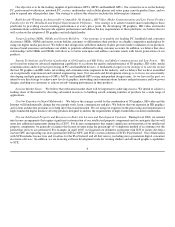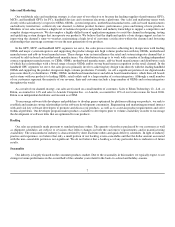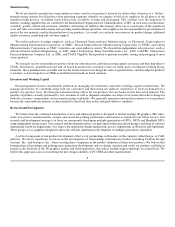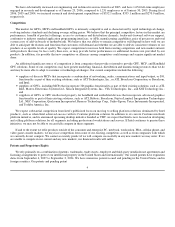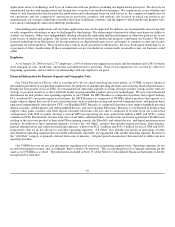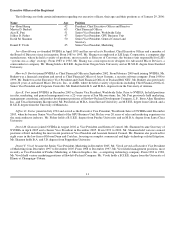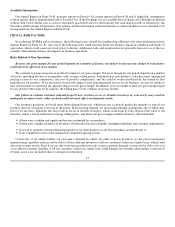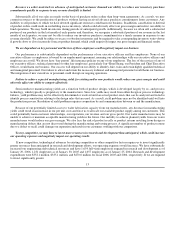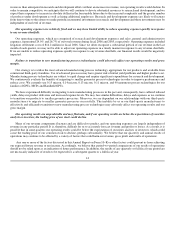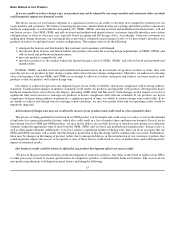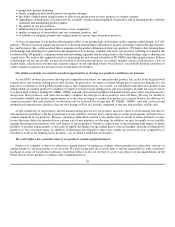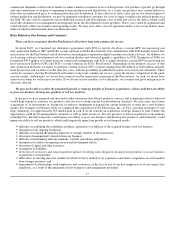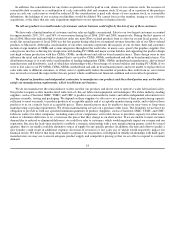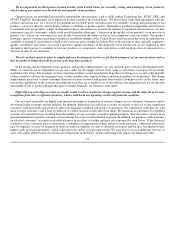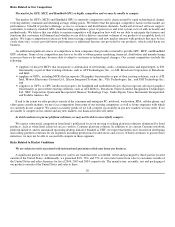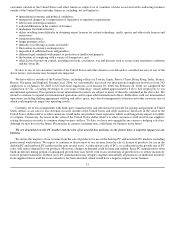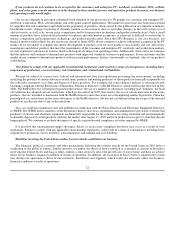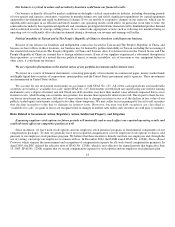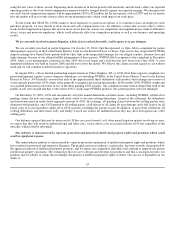NVIDIA 2006 Annual Report Download - page 20
Download and view the complete annual report
Please find page 20 of the 2006 NVIDIA annual report below. You can navigate through the pages in the report by either clicking on the pages listed below, or by using the keyword search tool below to find specific information within the annual report.
resources than anticipated in research and development efforts without an increase in revenue, our operating results would decline. In
order to remain competitive, we anticipate that we will continue to devote substantial resources to research and development, and we
expect these expenses to increase in absolute dollars in the foreseeable future due to the increased complexity and the greater number
of products under development as well as hiring additional employees. Research and development expenses are likely to fluctuate
from time to time to the extent we make periodic incremental investments in research and development and these investments may be
independent of our level of revenue.
Our operating expenses are relatively fixed and we may have limited ability to reduce operating expenses quickly in response
to any revenue shortfalls.
Our operating expenses, which are comprised of research and development expenses and sales, general and administrative
expenses, represented 24.0% and 26.7% of our total revenue during fiscal 2006 and 2005, respectively. Operating expenses included
litigation settlement costs of $14.2 million in fiscal 2006. Since we often recognize a substantial portion of our revenue in the last
month of each quarter, we may not be able to adjust our operating expenses in a timely manner in response to any revenue shortfalls.
If we are unable to reduce operating expenses quickly in response to any revenue shortfalls, our financial results would be negatively
impacted.
Failure to transition to new manufacturing process technologies could adversely affect our operating results and gross
margin.
Our strategy is to utilize the most advanced manufacturing process technology appropriate for our products and available from
commercial third−party foundries. Use of advanced processes may have greater risk of initial yield problems and higher product cost.
Manufacturing process technologies are subject to rapid change and require significant expenditures for research and development.
We continuously evaluate the benefits of migrating to smaller geometry process technologies in order to improve performance and
reduce costs. We currently use 0.15 micron, 0.14 micron, 0.13 micron, 0.11 micron, and 90 nanometer process technologies for our
families of GPUs, MCPs and Handheld GPUs.
We have experienced difficulty in migrating to new manufacturing processes in the past and, consequently, have suffered reduced
yields, delays in product deliveries and increased expense levels. We may face similar difficulties, delays and expenses as we continue
to transition our products to smaller geometry processes. Moreover, we are dependent on our relationships with our third−party
manufacturers to migrate to smaller geometry processes successfully. The inability by us or our third−party manufacturers to
effectively and efficiently transition to new manufacturing process technologies may adversely affect our operating results and our
gross margin.
Our operating results are unpredictable and may fluctuate, and if our operating results are below the expectations of securities
analysts or investors, the trading price of our stock could decline.
Many of our revenue components fluctuate and are difficult to predict, and our operating expenses are largely independent of
revenue in any particular period. It is, therefore, difficult for us to accurately forecast revenue and profits or losses. As a result, it is
possible that in some quarters our operating results could be below the expectations of securities analysts or investors, which could
cause the trading price of our common stock to decline, perhaps substantially. We believe that our quarterly and annual results of
operations may continue to be affected by a variety of factors that could harm our revenue, gross profit and results of operations.
Any one or more of the factors discussed in this Annual Report on Form 10−K or other factors could prevent us from achieving
our expected future revenue or net income. Accordingly, we believe that period−to−period comparisons of our results of operations
should not be relied upon as an indication of future performance. In addition, the results of any quarterly or full fiscal year period are
not necessarily indicative of results to be expected for a subsequent quarter or a full fiscal year.
14




